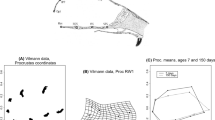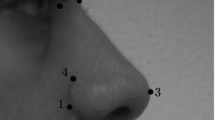Abstract
Most of the studies in medical and biological sciences are related to the examination of geometrical properties of an organ or organism. Growth and allometry studies are important in the way of investigating the effects of diseases and the environmental factors effects on the structure of the organ or organism. Thus, statistical shape analysis has recently become more important in the medical and biological sciences. Shape is all geometrical information that remains when location, scale and rotational effects are removed from an object. Allometry, which is a relationship between size and shape, plays an important role in the development of statistical shape analysis. The aim of the present study was to compare two different models for allometry which includes tangent coordinates and principal component scores of tangent coordinates as dependent variables in multivariate regression analysis. The results of the simulation study showed that the model constructed by taking tangent coordinates as dependent variables is more appropriate than the model constructed by taking principal component scores of tangent coordinates as dependent variables, for all sample sizes.









Similar content being viewed by others
References
Ercan I, Ocakoglu G, Sigirli D, Ozkaya G (2012) Statistical shape analysis and usage in medical sciences. Turkiye Klinikleri J Biostat 4:27–35
Galilei G, Crew H, de Salvio A (1952) Dialogues concerning two new sciences. The Macmillan Company, New York
Thompson DW (1942) On growth and form. University Press, New York
Lele SR, Richtsmeier JT (2001) An invariant approach to statistical analysis of shapes. Chapman & Hall/CRC, Florida
Huxley JS (1924) Constant differential growth-ratios and their significance. Nature 114:895–896
Jolicoeur P (1963) The multivariate generalization of the allometry equation. Biometrics 19:497–499
Klingenberg CP (1998) Heterochrony and allometry: the analysis of evolutionary change in ontogeny. Biol Rev Camb Philos Soc 73(1):79–123
Mosimann JE (1970) Size allometry: size and shape variables with characterizations of the lognormal and generalized gamma distributions. J Am Statist Assoc 65:930–945
Gould SJ (1975) Allometry in primates, with emphasis on scaling and the evolution of the brain. Contrib Primatol 5:244–292
Dryden IL, Mardia KV (1998) Statistical shape analysis. Wiley, Chichester
Goodall C (1991) Procrustes methods in the statistical analysis of shape. J R Statist Soc B 53:285–339
Bookstein FL (1986) Size and shape spaces for landmark data in two dimensions. Statist Sci 1(2):181–222
Kendall DG (1984) Shape manifolds, procrustean metrics, and complex projective spaces. Bull London Math Soc 16(2):81–121
Hammer Ø, Harper DAT (2005) Paleontological data analysis. Wiley, Blackwell, Oxford
Berge C, Penin X (2004) Ontogenetic allometry, heterochrony, and interspecific differences in the skull of African apes, using tridimensional Procrustes analysis. Am J Phys Anthropol 124:124–138
Zelditch ML, Swiderski DL, Sheets HD, William LF (2004) Geometric morphometrics for biologists. Elsevier, Amsterdam
Witelson SF (1989) Hand and sex differences in the isthmus and genu of the human corpus callosum a postmortem morphological study. Brain 112(3):799–835
Ozdemir ST, Ercan I, Sevinc O, Guney I, Ocakoglu G, Aslan E, Barut C (2007) Statistical shape analysis of differences in the shape of the corpus callosum between genders. Anat Rec 290(7):825–830
Sigirli D, Ercan I (2012) Examining growth with statistical shape analysis and comparison of growth models. J Mod Appl Stat Methods 11(2):479–492
Cardini A, Thorington RW Jr (2006) Postnatal ontogeny of marmot (Rodentia, Sciuridae) crania: allometric trajectories and species divergence. J Mammal 87:201–215
Sardi ML, Ventrice F, Ramírez RF (2007) Allometries throughout the late prenatal and early postnatal human craniofacial ontogeny. Anat Rec 290(9):1112–1120
Márquez F, Gonzalez-Jose R, Bigatti G (2011) Combined methods to detect pollution effects on shell shape and structure in Neogastropods. Ecol Indic 11(2):248–254
Frost SR, Marcus LF, Bookstein FL, Reddy DP, Delson E (2003) Cranial allometry, phylogeography, and systematics of large bodied papionins (primates: Cercopithecinae) inferred from geometric morphometric analysis of landmark data. Anat Rec A Discov Mol Cell Evol Biol 275:1048–1072
Cardini A, Elton S (2007) Sample size and sampling error in geometric morphometric studies of size and shape. Zoomorphology 126:121–134
Author information
Authors and Affiliations
Corresponding author
Rights and permissions
About this article
Cite this article
Sigirli, D., Ercan, I. Examining the Efficiency of Models Using Tangent Coordinates or Principal Component Scores in Allometry Studies. Interdiscip Sci Comput Life Sci 7, 249–256 (2015). https://doi.org/10.1007/s12539-015-0026-x
Received:
Revised:
Accepted:
Published:
Issue Date:
DOI: https://doi.org/10.1007/s12539-015-0026-x




